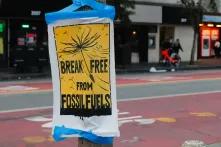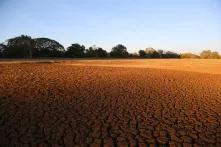
In its latest assessment report the Intergovernmental Panel on Climate Change (IPCC) states that one in three people is extremely vulnerable to climate change.[1] This vulnerability is intertwined with social inequality and therefore unequally distributed across the globe. The assessment results emphasize a central question of our time: how can we protect affected population and adapt to present and future change in the climate?

When the adverse effects of climate change render formerly populated zones of the planet uninhabitable, affected people sometimes migrate to other regions. It is primary sea-level rise and and extreme weather or climate events – such as prolonged droughts, hurricanes or floods – that drive people away from home. In addition, gradual ‘slow-onset’ environmental changes that takes place over a longer period of time, such as changes in temperature or precipitation, can also play a role in people’s decisions to migrate. For example, life in many rural communities in East Africa depends on natural resources and farmers rely on rainfall and soil fertility to produce their food. When the availability of resources deteriorates because of changing environmental conditions, livelihoods are threatened. Next to agricultural measures, migration can be one possible adaptation strategy to improve people’s well-being.
Displacement due to extreme weather events is now a global phenomenon
Last summer, a disastrous flood in the German Ahr valley and surrounding areas devastated the region. As a consequence many people lost their homes – some are now busy rebuilding them, others have moved away temporarily or permanently. This has harrowingly illustrated the harmful impacts of extreme weather events which are becoming more frequent due to the world’s rapidly changing climate. In the U.S., individual and household decisions to relocate to other areas is increasingly driven by the experience of heat waves or fires in the previous area of residence. In Bangladesh, coastal areas are already witnessing more frequent and intensified flooding and cyclones, leading to salinization and the loss of habitable land. Those who can afford to move have built more resilient homes on higher grounds or sent family members to work in nearby cities.
Displacement due to extreme weather events is now a global phenomenon, with the populations of small island states in the Pacific and people in Africa and Asia being most affected. According to the Internal Displacement Monitoring Center (IDMC), at least 20 million people are displaced within their national borders each year, roughly equivalent to the number of inhabitants of Beijing. Most of them move only short distances; in the context of climate extremes, international migration is much less common. Some people – if possible – also return to their places of residence at a later date.
Migration is a matter of climate justice
In recent years, research in this area has increased, including questions about whether and how hotter climates, changes in rainfall or infertile soils influence migration behaviors. Researchers have found that environmental changes can both promote and inhibit migration. Such findings suggest migration is not only influenced by the environment but depends on several interrelated contextual factors: financial resources, social networks, personal desires, political institutions, and changes in environmental conditions are all potential factors that influence people’s decision to move or stay put.
Although more and more people experience the adverse effects of climate change, whether they can or want to migrate depends on their circumstances, opportunities and resources. Moreover, the vulnerable populations most impacted by climate change are often the ones least responsible. Migration in the context of climate change is therefore also a matter of climate justice. Environmental change often increases the pressure on households but, besides migration, people can also resort other adaptation strategies. Moreover, out-migration is usually expensive, and the poorest can often barely afford mobility.
Against the backdrop of an ongoing increase in climate change, climate-induced migration plays a crucial role in adapting to these changing environmental conditions. More and more people worldwide are affected, and it is a fact that some regions in the global South will eventually become uninhabitable. However, there are still significant gaps in our knowledge about what exactly these migrations will look like and how extensive they will be in the future. This is because the interrelationship of migration and climate change remains complex and takes diverse forms.
Alarmist warnings about “climate refugees” lack a scientific basis and do not help those affected by climate change
Ahead of the climate negotiations at Cop26 in Glasgow, Boris Johnson announced that failure to act on climate change could prompt “very difficult geopolitical events” including mass migration and global competition for food and water. In 2015, John Kerry had also warned of “waves of refugees” triggered by climate change. Western government representatives frequently use the rhetoric of a climate exodus either to emphasize climate protection or to legitimize tighter border control. Besides, several reports[2] from the past years have produced alarmist media headlines heralding a climate-induced mass exodus.
The narrative of a mass movement of refugees triggered by climate change and headed towards the global North is omnipresent in media headlines and political negotiations. However, alarmist warnings about “climate refugees” (regardless of the intention with which they are voiced) not only lack a scientific basis; they also play into the hands of those who argue in favor of restrictive border policies instead of helping those whose livelihoods are seriously harmed by climate change.
Figures that measure or predict climate-induced migration flows are extremely difficult to create
The assumption that masses of “climate refugees” are heading for Europe is often accompanied by attempts to predict these migration movements in numbers. In the 1990s biodiversity scientist Norman Myers predicted a total of 200 million “climate refugees” by the mid-21st century. However, his projection was based on highly simplified assumptions of how climate change would impact people’s migration behavior, and it has been heavily criticized by migration scholars. Nevertheless, his data have continued to circulate in the public sphere and have been reproduced in reports by several NGOs. Given the complexity and multi-causality of migration dynamics, it is extremely difficult to measure or predict climate-induced migration flows. Although most attempts to quantify so-called “climate refugees” have produced rather unreliable data and results, their public impact has been powerful. Scientists and other critics have repeatedly warned against the myth surrounding “climate migration”. With reference to the growing body of knowledge on the climate-migration-nexus, many are calling for a more nuanced account of the nexus and a more differentiated political debate.
We need a more nuanced portrayal of climate mobility
Since the 1980s, different narratives on climate migration and various perceptions of the figure of the “climate refugee” have been circulating in the public debate. As early as the 1990s, people on the move were associated with the notion of helpless victims of climate change dependent on aid from the global North. As climate change became more and more narrated through a security framing in the 2000s, the interpretation of “climate refugees” evolved to the point of becoming a security threat. Since 2010, a more hopeful interpretation has entered the debate: migration as a sensible and legitimate adaptation strategy to climate change. When people’s livelihoods are threatened by climate change, moving from a rural to an urban area can be an effective way of securing livelihoods. Migration as an adaptation strategy counters the narrative of chaos or threat with a more positive view of mobility. Still, the narrative of adaptation carries the risk of overemphasizing the responsibility of individuals to adapt and overlooking structural climate injustice.
In my examination of current German media coverage[3] I found that alarmist and simplified narratives on “climate migration” are very deeply embedded in public discourse. Climate-induced migration is nowadays still regularly presented as a chaotic mass phenomenon of the global South that is often linked to conflict. Within these narratives, the “climate refugee” is constructed as a threatening “other” and sometimes given paternalistic or even racist attributions. However, some of the current media coverage has also become differentiated and diversified. A more nuanced picture emerges in information-based articles that provide a more complex scientific classification of the phenomenon and incorporate recent research findings. In addition, feature articles or storytelling approaches describe subjective and individual mobility experiences. They approach the nexus from the micro-level, telling personal stories and, at their best, placing them in a larger historical and local context. In this process, various nuances and the complexity of mobility experiences can be conveyed, creating greater empathy with those affected. In some reports, local experts from the affected regions have their say, breaking the North-South hierarchy between experts on one side and victims on the other.
How can migration improve the well-being of populations affected by climate change?
The dominant narratives supported by media coverage have established the notion of “climate migration” as a crisis and a phenomenon originating in the global South that poses a burden on, or threat to, the global North. Moreover, the debate about “climate refugees” is predominantly led by experts from the global North, without adequate participation of those affected. This is also illustrated by the uneven distribution of scientific research: while most researchers are located in the global North, the areas of study are located in the global South. The “climate refugee” narratives are persistent because they fit into general social images that associate migration with fear and threat. Not least because of this common interpretation of migration as a threat, people in Europe often ask how climate-induced migration can be avoided. However, this is not necessarily the right question. Migration has always been part of human behavior, and it is not good or bad per se. Being or becoming mobile can have both positive and negative effects on human well-being. Migration can be an adaption strategy to cope with environmental change. The important question is: how can migration improve the well-being of people affected by climate change? Policy responses should aim to support the positive effects of migration and help minimize negative ones. They should be human-centered and support affected regions and people, e.g. through resettlement measures, support for diverse forms of human mobility, and facilitation of safe migration movements.
[1] IPCC. 2022. “Summary for Policymakers”. In: Climate Change 2022: Impacts, Adaption and Vulnerability. Contribution of Working Group II to the Sixth Assessment Report of the Intergovernmental Panel on Climate Change.
[2] Rigaud et al. 2018. “„Groundswell: Preparing for internal climate migration“”. Washington, DC: The World Bank.
Institute for Economics & Peace. 2020. “„Ecological Threat Register 2020“”. Institute for Economics & Peace.
[3] I used a search term to collect articles on the climate-mobility-nexus from “Die Welt” and “Süddeutsche Zeitung” in the time frame 2015 – 2020. Afterwards I analyzed how the articles discussed the topic and how the “climate refugee” figure is constructed and imagined.



